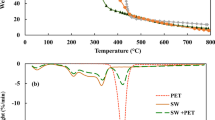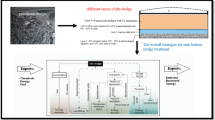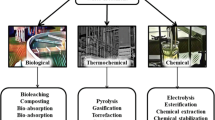Abstract
In this study, feedstock and energy recovery potential from fluid fraction of catalytic pyrolysis of poly(ethylene terephthalate) plastic waste in the presence of marble processing effluent physico-chemical sludge catalyst were investigated. The contribution of the study is both symbiotic disposal of two kinds of wastes and produced valuable products. The pyrolysis fluid products obtained at 300–700 °C and 10–50% catalyst dose were inquired via chemical, thermogravimetric and chromatographic means. Main recoverable compounds were in the benzene group, followed by the esters, alcohols and ketones. The variety of organic components in pyrolytic gas was detected in aliphatic compounds (alkanes and alkenes) followed by the oxygenated organics and aromatic compounds. Benzoic acid, Methanone diphenyl(benzophenone), 1,1biphenyl, 9H Fluorene, Octane, Methyl benzene, some Benzene and Heptene derivatives were the components that are easily recoverable from the pyrolytic fluids. All these recoverable components are economically important feedstocks utilized in industrial processes. Optimization of recovery and enrichment methods of these compounds is recommended for further study. More thermally stable products formed and the higher final thermal residue of pyrolytic oil and oligomer products were obtained at higher pyrolysis temperatures. Their T5, T10 and T50 values varied between 36–44, 44–54, and 72–84 °C, respectively, while they were 131–154, 141–160 and 217–313 °C for oligomers. Calorific values of the produced oligomers were in the range of 5541–6984 cal/g. This study indicated that the thermochemical degradation of poly(ethylene terephthalate) with marble sludge catalyst is important approach for material and energy recovery in terms of fluid products of the process.









Similar content being viewed by others
References
Ali MF, Qureshi MS (2013) Transportation fuels from catalytic co-pyrolysis of plastic wastes with petroleum residues: evaluation of catalysts by thermogravimetric analysis. Pet Sci Technol 31:1665–1673. https://doi.org/10.1080/10916466.2010.551239
AnuarSharuddin SD, Abnisa F, Wan Daud WMA, Aroua MK (2016) A review on pyrolysis of plastic wastes. Energy Convers Manag 115:308–326. https://doi.org/10.1016/j.enconman.2016.02.037
Artetxe M, Lopez G, Amutio M, Elordi G, Olazar M, Bilbao J (2010) Operating conditions for the pyrolysis of poly-(ethylene terephthalate) in a conical spouted-bed reactor. Ind Eng Chem Res 49:2064–2069. https://doi.org/10.1021/ie900557c
Ashish DK (2018) Feasibility of waste marble powder in concrete as partial substitution of cement and sand amalgam for sustainable growth. J Build Eng 15:236–242. https://doi.org/10.1016/j.jobe.2017.11.024
Awaja F, Pavel D (2005) Recycling of PET. Eur Polym J 41:1453–1477. https://doi.org/10.1016/j.eurpolymj.2005.02.005
Blazso M (2006) Composition of liquid fuels derived from the pyrolysis of plastics. In: Scheirs J, Kaminsky W (eds) Feedstock recycling and pyrolysis of waste plastics: Converting waste plastics into diesel and other fuel. John Wiley & Sons, USA
Blazso M (2010) Pyrolysis for recycling waste composites. In: Goodship V (ed) Management, recycling and reuse of waste composites. Woodhead Publishing, Delhi
Carroll GT, Turro NJ, Koberstein JT (2010) Patterning dewetting in thin polymer films by spatially directed photocrosslinking. J Colloid Interf Sci 351:556–560. https://doi.org/10.1016/j.jcis.2010.07.070
Chomba EM (2018) Pyrolysis of waste plastics into chemicals as an alternative to landfilling or incineration. Master Thesis, Stellenbosch University, South Africa. https://core.ac.uk/download/pdf/188225562.pdf
Cnudde P, de Wispelaere K, Van der Mynsbrugge J, Waroquier M, Van Speybroeck V (2017) Effect of temperature and branching on the nature and stability of alkene cracking intermediates in H-ZSM-5. J Catal 345:53–69. https://doi.org/10.1016/j.jcat.2016.11.010
Corinaldesi V, Moriconi G, Naik TR (2010) Characterization of marble powder for its use in mortar and concrete. Constr Build Mater 24:113–117. https://doi.org/10.1016/j.conbuildmat.2009.08.013
Das P, Tiwari P (2017) Thermal degradation kinetics of plastics and model selection. Thermochim Acta 654:191–202. https://doi.org/10.1016/j.tca.2017.06.001
Das AK, Hansdah D, Mohapatra AK, Panda AK (2020) Energy, exergy and emission analysis on a DI single cylinder diesel engine using pyrolytic waste plastic oil diesel blend. J Energy Inst 93:1624–1633. https://doi.org/10.1016/j.joei.2020.01.024
Dimitrov N, Krehula LK, Siročić AP, Hrnjak-Murgić Z (2013) Analysis of recycled PET bottles products by pyrolysis-gas chromatography. Polym Degrad Stabil 98:972–979. https://doi.org/10.1016/j.polymdegradstab.2013.02.013
Dorman G, Prestwich GD (1994) Benzophenone photophores in biochemistry. Biochem 33:5661–5673. https://doi.org/10.1021/bi00185a001
Dornath PJ (2010) Analysis of chemical leaching from common consumer plastic bottles under high stress conditions. A project, Oregon State University. http://hdl.handle.net/1957/17627
Du S, Valla JA, Parnas RS, Bollas GM (2016) Conversion of polyethylene terephthalate based waste carpet to benzene-rich oils through thermal, catalytic, and catalytic steam pyrolysis. ACS Sustain Chem Eng 4:2852–2860. https://doi.org/10.1021/acssuschemeng.6b00450
Dzieciol M, Trzeszczynski J (2001) Temperature and atmosphere influences on smoke composition during thermal degradation of poly(ethylene terephthalate). J Appl Polym Sci 81:3064–3068. https://doi.org/10.1002/app.1757
El Mejdoubi K, Sallek B, Cherkaoui H, Chaair H, Oudadesse H (2018) One-pot synthesis of dihydropyrimidinones/thiones catalyzed by white marble a metamorphic rock: an efficient and reusable catalyst for the biginelli reaction. Kinet Catal 59:290–295. https://doi.org/10.1134/S0023158418030126
Eldeeb MA, Akih-Kumgeh B (2018) Recent trends in the production, combustion and modeling of furan-based fuels. Energies 11:512. https://doi.org/10.3390/en11030512
Fujii M, Dou Y, Sun L, Ohnishi S, Maki S, Dong H, Dong L, Chandran R (2019) Contribution to a low-carbon society from improving exergy of waste-to-energy system by upgrading utilization of waste. Resour Conserv Recycl 149:586–594. https://doi.org/10.1016/j.resconrec.2019.06.038
Goodings EP (1961) Thermal degradation of poly(ethylene terephthalate). J Soc Chem Ind Monogr 13:211–228
Gopinath S, Devan PK, Pitchandi K (2020) Production of pyrolytic oil from ULDP plastics using silica-alumina catalyst and used as fuel for DI diesel engine. RSC Adv 10:37266–37279. https://doi.org/10.1039/D0RA07073D
Grause G, Kaminsky W, Fahrbach G (2004) Hydrolysis of poly (ethylene terephthalate) in a fluidised bed reactor. Polym Degrad Stabil 85:571–575. https://doi.org/10.1016/j.polymdegradstab.2003.10.020
Grause G, Handa T, Kameda T, Mizoguchi T, Yoshioka T (2011) Effect of temperature management on the hydrolytic degradation of PET in a calcium oxide filled tube reactor. Chem Eng J 166:523–528. https://doi.org/10.1016/j.cej.2010.11.010
Griesbaum K, Behr A, Biedenkapp D, Voges HW, Garbe D, Paetz C, Collin G, Mayer D, Höke H (2000) Hydrocarbons. Ullmann’s Encyclop Indus Chem, Weinheim. https://doi.org/10.1002/14356007.a13_227
Gupta J, Agarwal M, Dalai AK (2018) Marble slurry derived hydroxyapatite as heterogeneous catalyst for biodiesel production from soybean oil. Can J Chem Eng 96:1873–1880. https://doi.org/10.1002/cjce.23167
Holland BJ, Hay JN (2002) The thermal degradation of PET and analogous polyesters measured by thermal analysis–Fourier transform infrared spectroscopy. Polymer 43:1835–1847. https://doi.org/10.1016/S0032-3861(01)00775-3
Honus S, Kumagai S, Fedorko G, Molnár V, Yoshioka T (2018) Pyrolysis gases produced from individual and mixed PE, PP, PS, PVC, and PET—Part I: production and physical properties. Fuel 221:346–360. https://doi.org/10.1016/j.fuel.2018.02.074
Kaewpengkrow P, Atong D, Sricharoenchaikul V (2012) Pyrolysis and gasification of landfilled plastic wastes with Ni−Mg−La/Al2O3 catalyst. Environ Technol 33:2489–2495. https://doi.org/10.1080/09593330.2012.680918
Kavustu S (2013) Co-pyrolysis of polystyrene and polyolefin plastic wastes. Master Thesis, Ankara University. https://dspace.ankara.edu.tr/xmlui/handle/20.500.12575/33052
Kremer I, Tomić T, Katančić Z, Erceg M, Papuga S, ParlovVuković J, Schneider DR (2022) Catalytic pyrolysis and kinetic study of real-world waste plastics: multi-layered and mixed resin types of plastics. Clean Techn Environ Policy 24:677–693. https://doi.org/10.1007/s10098-021-02196-8
Kumagai S, Yoshioka T (2016) Feedstock recycling via waste plastic pyrolysis. J Japan Pet Inst 59:243–253. https://doi.org/10.1627/jpi.59.243
Kumagai S, Hasegawa I, Grause G, Kameda T, Yoshioka T (2015) Thermal decomposition of individual and mixed plastics in the presence of CaO or Ca(OH)2. J Anal Appl Pyrolysis 113:584–590. https://doi.org/10.1016/j.jaap.2015.04.004
Kumar S, Panda AK, Singh RK (2011) A review on tertiary recycling of high-density polyethylene to fuel. Resour Conserv Recycl 55:893–910. https://doi.org/10.1016/j.resconrec.2011.05.005
Kumar S, Prakash R, Murugan S, Singh RK (2013) Performance and emission analysis of blends of waste plastic oil obtained by catalytic pyrolysis of waste HDPE with diesel in a CI engine. Energy Convers Manag 74:323–331. https://doi.org/10.1016/j.enconman.2013.05.028
Kurdyukova IV, Ishchenko AA (2012) Organic dyes based on fluorene and its derivatives. Russ Chem Rev 81:258–290. https://doi.org/10.1070/RC2012v081n03ABEH004211
Larranaga MD, LewisLewis RJSRRA (2016) Hawley’s condensed chemical dictionary, 16th edn. John Wiley & Sons, Inc., Hoboken
Lazdovica K, Kampars V (2017) Catalytic pyrolysis of wheat straw in the presence of inexpensive calcium-based catalysts by using TGA-FTIR method. Mater Method Technol 11:8–17
Li C, Ataei F, Atashi F, Hu X, Gholizadeh M (2021) Catalytic pyrolysis of polyethylene terephthalate over zeolite catalyst: characteristics of coke and the products. Int J Energy Res 45:19028–19042. https://doi.org/10.1002/er.7078
Lopez G, Artetxe M, Amutio M, Bilbao J, Olazar M (2017) Thermochemical routes for the valorization of waste polyolefinic plastics to produce fuels and chemicals. A review. Renew Sustain Energy Rev 73:346–368. https://doi.org/10.1016/j.rser.2017.01.142
Maki T, Takeda K (2013) Benzoic acid and derivatives. Ullmann’s encyclopedia of industrial chemistry. John Wiley & Sons, New York
Mangesh VL, Padmanabhan S, Tamizhdurai P, Ramesh A (2020) Experimental investigation to identify the type of waste plastic pyrolysis oil suitable for conversion to diesel engine fuel. J Clean Prod 246:119066. https://doi.org/10.1016/j.jclepro.2019.119066
Mathiarasu A, Pugazhvadivu M (2019) Production of bio-oil from soapnut seed by microwave pyrolysis. IOP Conference Series: Earth Environ Sci 312, Karaikal, U.T of Puducherry, India
Matrapazi VK, Zabaniotou A (2020) Experimental and feasibility study of spent coffee grounds upscaling via pyrolysis towards proposing an eco-social innovation circular economy solution. Sci Total Environ 718:137316. https://doi.org/10.1016/j.scitotenv.2020.137316
Miandad R, Rehan M, Barakat MA, Aburiazaiza AS, Khan H, Ismail IMI, Dhavamani J, Gardy J, Hassanpour A, Nizami AS (2019) Catalytic pyrolysis of plastic waste: moving toward pyrolysis based biorefineries. Front Energy Res 7:e27. https://doi.org/10.3389/fenrg.2019.00027
Mishra A, Pandey A, Maheshwari P, Chouhan A, Suresh S, Das S (2013) Green cement for sustainable concrete using marble dust. Int J ChemTech Res 5:616–622
Miskolczi N, Ateş F (2016) Thermo-catalytic co-pyrolysis of recovered heavy oil and municipal plastic wastes. J Anal Appl Pyrolysis 117:273–281. https://doi.org/10.1016/j.jaap.2015.11.005
Nakajima H, Dijkstra P, Loos K (2017) The recent developments in biobased polymers toward general and engineering applications: polymers that are upgraded from biodegradable polymers, analogous to petroleum-derived polymers, and newly developed. Polymers 9:523. https://doi.org/10.3390/polym9100523
Nasier S (2021) Utilization of recycled form of concrete, E-wastes, glass, quarry rock dust and waste marble powder as reliable construction materials. Mater Today: Proc 45:3231–3234. https://doi.org/10.1016/j.matpr.2020.12.381
Noreña L, Aguilar J, Mugica V, Gutiérrez M, Torres M (2012) Materials and methods for the chemical catalytic cracking of plastic waste, material recycling-trends and perspectives. In: Achilias D (ed) material recycling-trends and perspectives. IntechOpen, UK
Onen V, Beyazyuz P, Yel E (2018) Removal of turbidity from travertine processing wastewaters by coagulants, flocculants and natural materials. Mine Water Environ 37:482–492. https://doi.org/10.1007/s10230-017-0499-4
Onen V, Ozgan A, Goktepeli G, Kalem M, Ahmetli G, Yel E (2023) Marble processing efuent treatment sludge in waste PET pyrolysis as catalyst-I: pyrolysis product yields and the char characteristics. Int J Environ Sci Technol 20:3965–3986. https://doi.org/10.1007/s13762-022-04262-0
Ouellette RJ, Rawn JD (2015) Alkanes and cycloalkanes. In: Ouellette RJ, Rawn JD (eds) Principles of organic chemistry. Elsevier, UK
Petrovic SC (2017) Gas Chromatography of alkanes: introducing quantitative structure retention relationship (QSRR) models in the instrumental analysis laboratory. Chem Educator 22:154–162. https://doi.org/10.1333/s00897172766a
Pistor V, Ornaghi FG, Fiorio R, Zattera AJ (2010) Thermal characterization of oil extracted from ethylene–propylene–diene terpolymer residues (EPDM-r). Thermochim Acta 510:93–96. https://doi.org/10.1016/j.tca.2010.06.028
Prasad SG, De A, De U (2011) Structural and optical investigations of radiation damage in transparent PET polymer films. Int J Spectrosc 2011:810936. https://doi.org/10.1155/2011/810936
Quesada L, Calero M, Martín-Lara MA, Pérez A, Paucar-Sánchez MF, Blázquez G (2022) Characterization of the different oils obtained through the catalytic in situ pyrolysis of polyethylene film from municipal solid waste. Appl Sci 12:4043. https://doi.org/10.3390/app12084043
Rizzo G, D’Agostino FABIO, Ercoli L (2008) Problems of soil and groundwater pollution in the disposal of “marble” slurries in NW Sicily. Environ Geology 55:929–935. https://doi.org/10.1007/s00254-007-1043-9
Roozbehani B, Motevassel M, Mirdrikvand M, Imani Moqadam S, Kharaghani A (2017) Gasoline production from a polymeric urban disposal mixture using silica–alumina catalyst. Clean Techn Environ Policy 19:123–136. https://doi.org/10.1007/s10098-016-1196-x
Rowe RC, Sheskey PJ, Quinn ME (2009) Handbook of pharmaceutical excipients, 6th edn. Pharmaceutical Press, London, England
Salam JJ, Titinchi KFS, Abbo HS, Hammerich O (2008) The synthesis of mono- and diacetyl-9H-fluorenes. Reactivity and selectivity in the Lewis acid catalyzed Friedel-Crafts acetylation of 9H-fluorene. ARKIVOC 13:91–105. https://doi.org/10.3998/ark.5550190.0009.d11
Savage PE (2000) Mechanisms and kinetics models for hydrocarbon pyrolysis. J Anal Appl Pyrolysis 54:109–126. https://doi.org/10.1016/S0165-2370(99)00084-4
Shahi A, Roozbehani B, Mirdrikvand M (2022) Catalytic pyrolysis of waste polyethylene terephthalate granules using a Lewis-Brønsted acid sites catalyst. Clean Technol Environ Policy 24:779–787. https://doi.org/10.1007/s10098-021-02260-3
Shukla S, Kulkarni K (2002) Depolymerization of poly (ethylene terephthalate) waste. J Appl Polym Sci 85:1765–1770. https://doi.org/10.1002/app.10714
Singh RK, Ruj B, Sadhukhan AK, Gupta P (2019) Impact of fast and slow pyrolysis on the degradation of mixed plastic waste: product yield analysis and their characterization. J Energy Inst 92:1647–1657. https://doi.org/10.1016/j.joei.2019.01.009
Snegirev AY, Handawy MK (2021) Thermocatalytic degradation of common polymers: a microscale combustion calorimetry study. Thermochim Acta 704:179016. https://doi.org/10.1016/j.tca.2021.179016
SoganciogluKalem M, Ozgan Kurt A, Goktepeli G, Onen V, Ahmetli G, Yel E (2023) The role of physicochemical marble processing wastewater treatment sludge in the production of new generation pyrolysis char from waste polypropylene. Environ Technol, in Press. https://doi.org/10.1080/09593330.2023.2224927
Sophonrat N, Sandström L, Johansson AC, Yang W (2017) Co-pyrolysis of mixed plastics and cellulose: an interaction study by Py-GC× GC/MS. Energy Fuels 31:11078–11090. https://doi.org/10.1021/acs.energyfuels.7b01887
Tasligil N, Sahin G (2016) Yapı malzemesi olarak kullanılan Türkiye doğal taşlarının iktisadi coğrafya odağında analizi. J Marmara Geography 33:607–640. https://doi.org/10.14781/mcd.95032
Terakado O, Hirasawa M (2005) Effect of metal oxides on the pyrolysis residues of poly (ethylene terephthalate): formation of carbonaceous submicron, nano-scale filaments and mesoporous compounds. J Anal Appl Pyrolysis 73:248–256. https://doi.org/10.1016/j.jaap.2005.02.002
Tulashie SK, Boadu EK, Dapaah S (2019) Plastic waste to fuel via pyrolysis: a key way to solving the severe plastic waste problem in Ghana. Therm Sci Eng Prog 11:417–424. https://doi.org/10.1016/j.tsep.2019.05.002
Uguz G, Ayanoğlu A (2021) Characterization of waste tire pyrolysis products by GC, ICP-MS, TGA and DSC. BEU J Sci 10:930–942. https://doi.org/10.17798/bitlisfen.840108
URL-1. https://www.fao.org/food/food-safety-quality/scientific-advice/jecfa/jecfa-flav/details/en/c/743/
URL-10. EPA/Office of Pollution Prevention and Toxics; High Production Volume (HPV) Challenge Program. Methanone, diphenyl- (119–61–9). Available from, as of December 12, 2014. https://www.epa.gov/hpv/pubs/general/opptsrch.htm; 1,1’-Biphenyl (92–52–4). Available from, as of April 27, 2005. https://www.epa.gov/hpv/pubs/general/opptsrch.htm
URL-12. https://www.transparencymarketresearch.com/fluorene-market.html
URL-3. https://pubchem.ncbi.nlm.nih.gov/compound/Benzoic-acid
URL-5. European Commission/European Chemical Substances Information System; IUCLID Dataset, Benzophenone (CAS No. 119–61–9), 2000. https://esis.jrc.ec.europa.eu/
URL-6. https://pubchem.ncbi.nlm.nih.gov/compound/3102#section=FEMA-Flavor-Profile
URL-7. DHHS/NTP; Toxicology and Carcinogenesis Studies of Benzophenone (CAS No. 119–61–9) Toxicity Report Series No. 61 NIH Pub No. 00–3943. Available from, as of March 18, 2015. https://ntp-server.niehs.nih.gov
URL-9. ACGIH-Documentation of the TLVs and BEIs, 7th Ed. Cincinnati:ACGIHWorldwide, 2020
Xu L, Na XW, Zhang LY, Dong Q, Dong GH, Wang YT, Fang Z (2019) Selective production of terephthalonitrile and benzonitrile via pyrolysis of polyethylene terephthalate (PET) with ammonia over Ca(OH)2/Al2O3 catalysts. Catalysts 9:436. https://doi.org/10.3390/catal9050436
Yanik J, Karayildirim T (2006) Liquefaction of municipal waste plastics over acidic and nonacidic catalysts. In: Scheirs J, Kaminsky W (eds) Feedstock recycling and pyrolysis of waste plastics: Converting waste plastics into diesel and other fuel. John Wiley & Sons, USA
Yilmazturk D (2011) Physico-chemical treatment of andesite processing wastewater. Master Thesis, Selcuk University. https://9lib.net/document/lq5r68rz-andezit-isleme-atiksuyunun-fizikokimyasal-aritimi.html
Yoshioka T, Grause G, Eger C, Kaminsky W, Okuwaki A (2004) Pyrolysis of poly(ethylene terephthalate) in a fluidised bed plant. Polym Degrad Stabil 86:499–504. https://doi.org/10.1016/j.polymdegradstab.2004.06.001
Yoshioka T, Handa T, Grause G, Lei Z, Inomata H, Mizoguchi T (2005) Effects of metal oxides on the pyrolysis of poly (ethylene terephthalate). J Anal Appl Pyrolysis 73:139–144. https://doi.org/10.1016/j.jaap.2005.01.004
Acknowledgements
This study was financially supported by The Scientific and Technological Research Council of Turkey–TUBITAK and The Japan Society for the Promotion of Science (JSPS) Bilateral Joint Research Project under Grant Code [TUBITAK CAYDAG-118Y475] (Turkey) and [JSPS JPJSBP12019942] (Japan)
Author information
Authors and Affiliations
Contributions
G. A: Conceptualization, Methodology, Investigation, Data curation, Writing—Original Draft, A. O: Investigation, Methodology, Data curation, V. O: Formal analysis, Conceptualization, Investigation, Data curation, Writing—Original Draft, Writing—Review & Editing, M. K: Validation, Methodology, Writing—Review & Editing. G. G: Resources, Conceptualization, Methodology, Investigation, Data curation, Writing—Review & Editing, E. Y: Project administration, Funding acquisition, Supervision, Visualization, Writing—Review & Editing.
Corresponding author
Ethics declarations
Conflict of interest
The authors declare that they have no conflict of interest.
Additional information
Editorial responsibility: Nour Sh. El-Gendy.
Supplementary Information
Below is the link to the electronic supplementary material.
Rights and permissions
Springer Nature or its licensor (e.g. a society or other partner) holds exclusive rights to this article under a publishing agreement with the author(s) or other rightsholder(s); author self-archiving of the accepted manuscript version of this article is solely governed by the terms of such publishing agreement and applicable law.
About this article
Cite this article
Ahmetli, G., Ozgan, A., Onen, V. et al. Marble processing effluent treatment sludge in waste poly(ethylene terephthalate) pyrolysis as catalyst–II: recovery from pyrolytic fluids. Int. J. Environ. Sci. Technol. 21, 6021–6042 (2024). https://doi.org/10.1007/s13762-023-05388-5
Received:
Revised:
Accepted:
Published:
Issue Date:
DOI: https://doi.org/10.1007/s13762-023-05388-5




